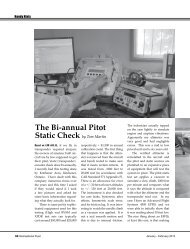September - October - The Recreational Aircraft Association
September - October - The Recreational Aircraft Association
September - October - The Recreational Aircraft Association
Create successful ePaper yourself
Turn your PDF publications into a flip-book with our unique Google optimized e-Paper software.
Sheet Metal Hole Cutting<br />
By Don Sinclair / We have all used standard drill bits for creating holes<br />
in our sheet metal, but as the holes get larger, standard drill bits are<br />
not always the best choice. When cutting larger holes there are few<br />
items that become more important than when making smaller holes.<br />
<strong>The</strong>se considerations include creating a round hole, keeping the centre<br />
where wanted, having the finished hole the diameter we intended,<br />
preventing the material from being distorted in the work area, and of<br />
course safety, both of the operator and the surroundings be it other<br />
people, tools, or aircraft structure.<br />
One of the least expensive ways to create large holes in sheet aluminum<br />
is the single blade fly cutter. <strong>The</strong>re is a reason this is the least<br />
expensive (under $20) way to cut holes of various sizes, and while<br />
it can create a good quality hole up to several inches in diameter,<br />
extreme care must be taken not to injure the operator or damage the<br />
work. <strong>The</strong> material needs to be securely clamped and the tool used in<br />
a very slow turning drill press to obtain good results. Attempts to use<br />
a fly cutter without taking these precautions or using it in a hand drill<br />
can easily become disastrous.<br />
A slightly safer approach is to use a single size bi-metal hole saw<br />
(under $10 for each size). This type of tool can create an acceptable<br />
hole, but again, there is a reason they are relatively inexpensive. Hole<br />
saws are easily dulled after a small number of holes, often resulting in<br />
the bit wandering and therefore leaving enlarged or oval holes.<br />
A better quality and significantly safer result from the first two mentioned<br />
methods can be obtained using a step drill ($15 each to $75 for<br />
a set of good quality bits). Like any type of tool, there are a variety of<br />
qualities out there, but versions up to about an inch are readily available.<br />
Once you have used this kind of tool, you will not want to go back<br />
to a fly cutter or hole saw when making holes of up to about an inch in<br />
diameter in sheet metal.<br />
A superior tool that doesn’t require much force applied to the sheet<br />
metal, thus virtually eliminating the chance of distorting the work area,<br />
especially on very thin material, and one that produces a high quality<br />
hole with very little burring, are ‘Annular Cutters’. One manufacturer<br />
of such annular cutters is Hougen (www.hougen.com, picture 1) and<br />
is available from a number of sources including the homebuilder tool<br />
supplier Avery Tools in Texas (www.averytools.com). Product names<br />
from Hougen include Rotabroach, RotaCut, and Holcutters. <strong>The</strong>se<br />
cutters safely create accurate and clean holes in sheet metal up to a<br />
couple of inches in diameter with little chance of hurtling your work<br />
across the shop. Material thickness of up to 1/8” or ¼” can be cut<br />
depending on the tool diameter. <strong>The</strong> smaller sizes (up to ¾” in diam-<br />
Top Down: Hougen's Annular cutter,<br />
Rotacut kit; Holcutter kit;<br />
and example of a hole cut by the Rotacut kit.<br />
continues<br />
<strong>September</strong> - <strong>October</strong> 2007 <strong>Recreational</strong> Flyer 29




